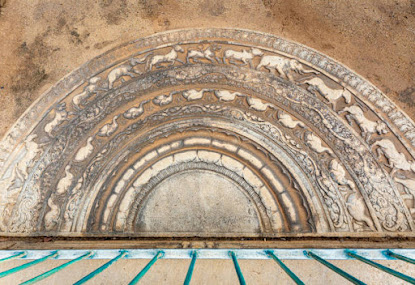Anuradhapura, the ancient capital of Sri Lanka, is an archaeological site of great significance. It was the seat of power for over 1,300 years and is home to a plethora of ancient ruins, temples, and monuments. It is time to explore these fabulous ancient ruins of Anuradhapura kingdom.
There are some popular ancient ruins around Anuradhapura. And among them my first visit was Ranmasu Uyana (Park). This was considered as the royal park during the pre-Christian era. The meaning of Ranmasu is Goldfish. According to the legend, there had been a pond with goldfish. The ruins of the park is spreading over 40 acres and most importantly, the stone made pond has the highest attraction than the other ruins. Thisa wewa(tank) is also located close to the Ranmasu Uyana. The park was established by King Thissa in 3rd century BC.
 |
| Every inch of the pond is made of stone. |
According to the sources, the ponds in this park was filled with the water from Thisa wewa. And there is a mystery sculpture in the park called ‘Star Gate’. Comparing the other sculptures, this one has a different and unique design. Archeologists suspect star gate as a type of ancient calendar. You can clearly see the pride history of a golden kingdom through these ancient ruins in Ranmasu Uyana.
Another attractive destination is Moonstone
alias Sandakadapahana. Moonstone is a well carved half circle stone slab which
was used as a kind of door mat. These
moonstones were placed in the entrance of temples.
 |
| Anuradhapura Moonstone |
Lovamahapaya, would definitely
surprise you by it’s amazing stone works. It was built by King Dutugamunu as a
home for the monks. There were nine floors for the building, and it is described
that the roof was made by bronze tiles. Even a man from a far away from
Anuradhapura, could clearly see the glittering roof of this amazing structure. It
was remained as the tallest building of the island over a millennium.
Unfortunately, the original building was destroyed by some reasons and now you
can only see the ruins. Though the building was destroyed, there are 1600 stone
pillars remained safe, which were used in the ground floor. These stone
pillars are well enough to prove the excellence of the constructions of ancient
Sri Lanka.
 |
| Strong stone pillars of Lovamahapaya |


0 Comments